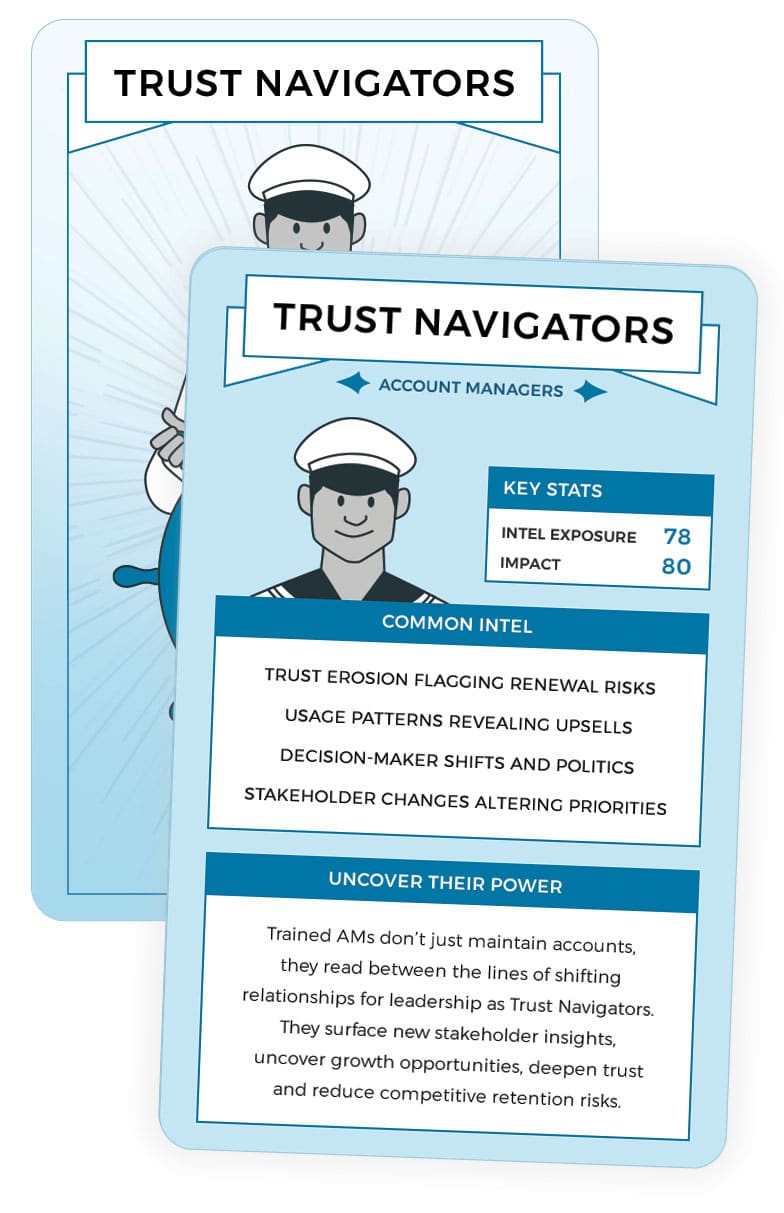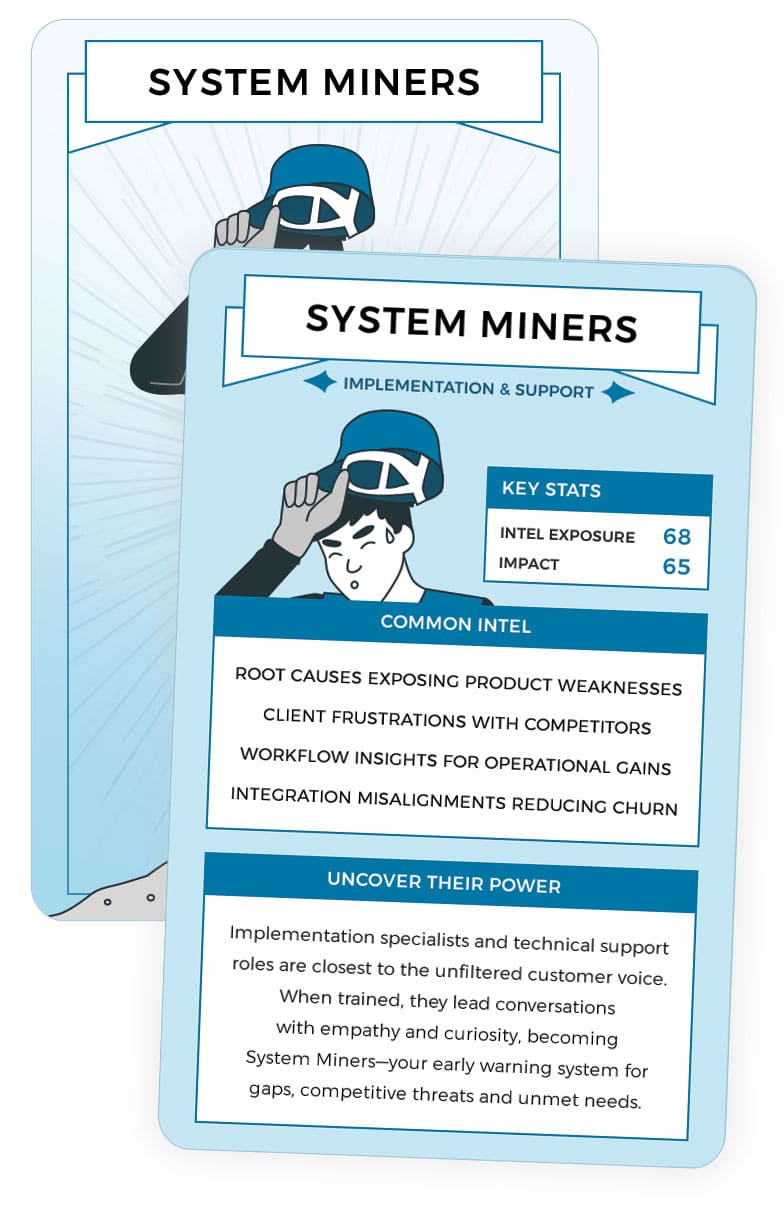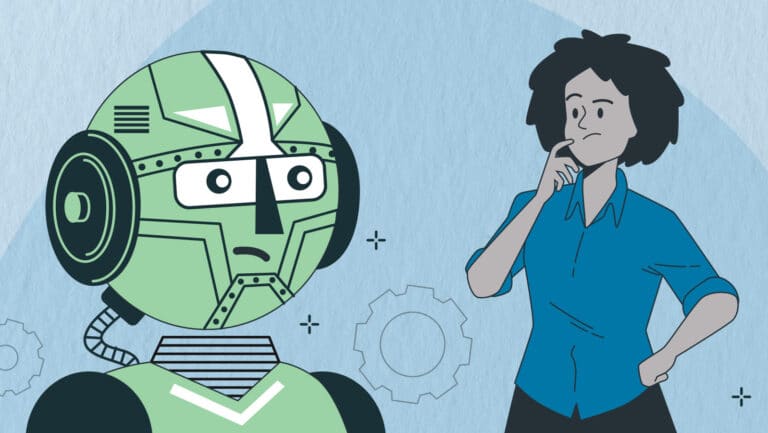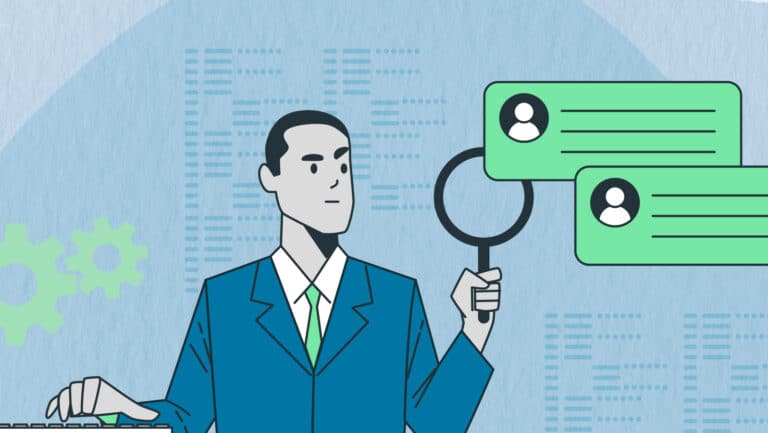executive snapshot
Leaders have never had more data at their fingertips, yet most still find themselves surprised by customer outcomes. Forecasts miss. Renewals stall. Deals disappear without clear explanation.
Across Hi-Q Group’s audits, the pattern is consistent. Companies spend heavily on CRM, analytics, and AI, but the customer insights they need to drive real growth often can’t be found in these systems. Yet they are surfacing in everyday conversations no one captures.
That gap explains why so many leaders are now under growing pressure to drive business value with their data. Every day, a new tech innovation promises to solve this burning problem, without addressing the underlying foundational intel gaps in organizations.
In a nutshell:
- CRMs contain data on what happened, but often not what matters.
- The lost customer insights from frontline teams hide a wealth of growth opportunities.
- To close this gap, perceptive leaders are focusing on the fundamentals: empowering customer-facing roles to find what truly matters to customers so this human intelligence can be surfaced in the organization, fully realizing the strength of AI-powered CRMs.
Customer intelligence isn’t new, but the way we pursue it has changed.
In the rush to digitize sales, marketing, and customer success, most organizations have confused data visibility with customer understanding and customer meetings with connection.
Dashboards became more robust, but customer conversations didn’t. Customer data started pouring into organizations, while meaningful engagements and handshakes seemingly became a relic of the past. As a result, teams are swimming in information yet starving for insight, and customer experience quality has fallen to an all-time low.
Until leadership can close that gap, every forecast, renewal, and expansion plan is built on assumptions, stalling growth and providing little clarity. That’s why the solution doesn’t lie behind increased tech stacks, but in the human intelligence layer of your customer-facing teams.
Why we’re still missing what matters most
Do you remember why you chose your last vendor?
Was it their solution, their marketing, or something else?
Most would be surprised to learn 95% of your purchase decisions take place unconsciously. The real reason you chose your vendor is likely not what immediately came to mind.
Zig Ziglar famously said, “People buy on emotion and justify on logic.”
Leaders instinctively know human connection is more powerful in business than presentation decks, features and benefits, data points or even technical knowledge. And they recognize meaningful customer engagements have the power to deliver exclusive insights you can’t find anywhere else.
Despite this, organizations continue to double down on tech and data investments outside of this human-to-human experience.
This results in high failure rates, because these investments can’t deliver their promised ROI without a human intelligence layer. When leaders assume technology will magically create strategic insights out of thin air, they end up scaling documentation, not discovery.
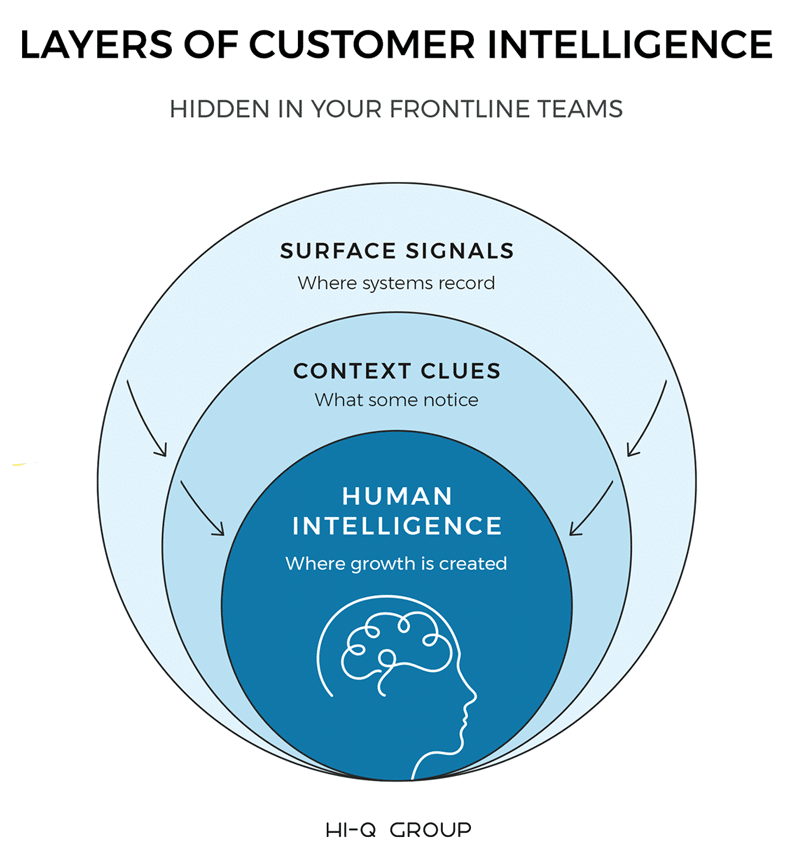
Without a human intelligence layer, clients often share their CRM has morphed into a forecasting and analytics platform instead of a holistic growth driver.
insight:
In short, even the most integrated CRM can’t fully explain what your customers actually think, feel, or need. That’s the human intelligence layer Hi-Q Group helps teams reclaim.
The silent disconnect blocking customer intelligence
B2B companies are sitting on a goldmine of customer intelligence and insights, and it lies in some of their most passionate and competent employees: their frontline teams.
These specialists have an advantage of customer intimacy, yet critical insights from their daily conversations never make it to the light of day.
Why? Inside every organization there’s a silent disconnect:
- The frontline thinks they know what customers want, but believe management doesn’t care about the details they notice.
- Leadership assumes frontline teams and their managers are already surfacing everything important.
Between those assumptions lies the intel gap—a gap wide enough to swallow entire pipelines and bring the most sophisticated technology to its knees. To close the gap, leaders must understand the potential trained frontline teams have in contributing unique intelligence that technology alone can’t reach.
dig deeper
Every organization has an intel gap: the space between what frontline teams hear and what your team knows. Identifying these gaps is the first step to closing it.
Our CRM Intel Assessment helps leadership teams pinpoint where valuable
customer insights are getting lost, and which fixes will deliver the fastest impact.
Your hidden intel “winning hand” against competitors
This intel gap for most B2B companies is considerable, but the good news is they also have a hidden “winning hand” of customer-facing roles sitting on a wealth of insights.
To tap into this, leading organizations are pairing their data investments with a pragmatic focus on the human-to-human experience necessary for powerful data-driven growth. They understand how critical frontline roles are in shaping the customer experience, and instead of avoiding this reality they lean into it: by training these roles to listen, identify, and surface customer intel their competitors have overlooked.
When these roles understand how to listen to the customer and open the door, they easily stack the odds in your favor and create an evergreen growth machine.

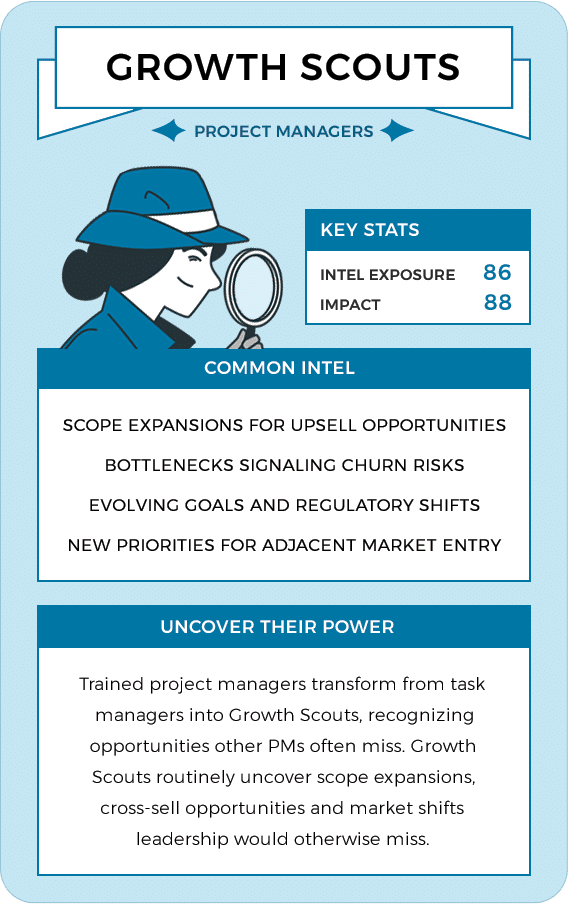


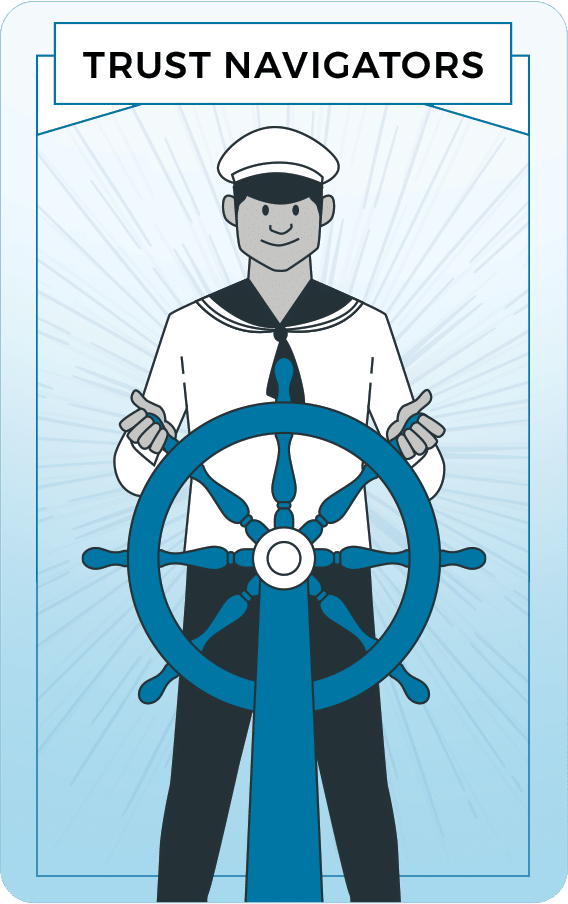
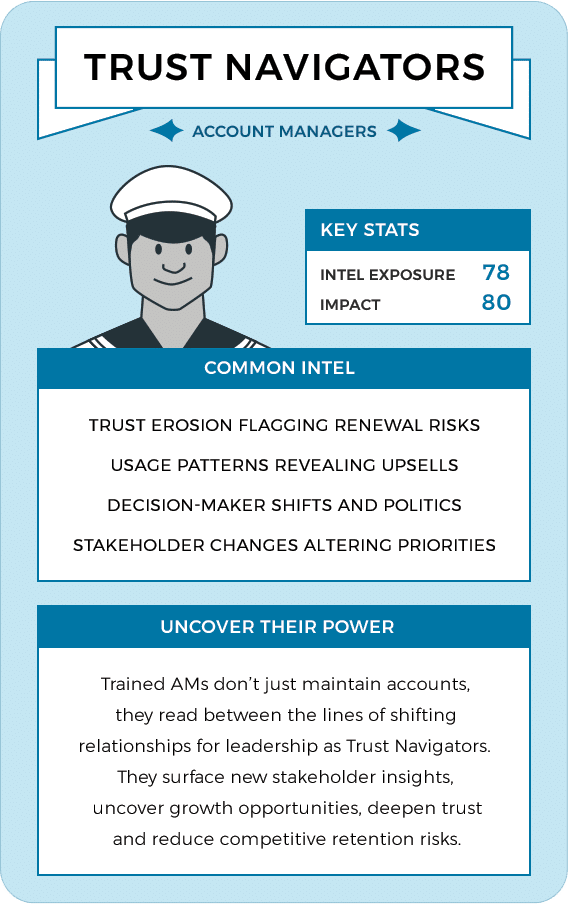


Here are a few examples of what this looks like in customer-centric organizations:
Project Managers (PMs): The Growth Scouts
In meeting audits, we often see PMs respond with some empathy, but no curiosity. They simply don’t get deep enough, missing growth opportunity signals.

Customer: “Sorry I’m late, they pulled me into a new AI initiative and the meeting ran over.”

PM: “Hey, no problem! I completely understand.”
Growth-trained PMs know to open the door instead:

PM: “That sounds interesting! What’s driving that change? That’s great! We’ve seen other clients exploring similar pilots. Would you like me to share insights of what we’ve learned?”
Why it matters:
When PMs learn to ask one well-placed probing question like, “What’s driving that change?” they transform from task managers into growth scouts, recognizing opportunities to serve the customer they may otherwise skip over.
This small behavioral shift routinely uncovers scope expansions, cross-sell opportunities, and market shifts that leadership would otherwise miss. They simply need a new meeting structure to lean on.
Subject Matter Experts (SMEs): The Double Threats
In meeting audits, SMEs rarely get to root cause as they are too quick to share their knowledge. They equate their credibility to quickly having a solution in mind and can be perceived as self-focused.

Customer: “Our teams are expanding into new markets, and we’re struggling with multi-language support.”

SME: “That’s easy. Our upgraded plan includes that feature.”
Growth-trained SMEs know a better approach:

SME: “Expansion is exciting, but there are usually surprises along the way. Which workflows are most impacted, and how’s that affecting your launch timelines?”
Why it matters:
When SMEs balance technical mastery with emotional intelligence—the “double threat”—they create new value. They stop pitching and start facilitating discovery, helping customers think through their problems before prematurely offering solutions.
This builds trust and chemistry, positions your team as the go-to partner, and opens the door for new growth opportunities. Instead of chasing customers, they will call your SME first when they need to talk through their options as a trusted resource that listens.
✦ CRM Intel Assessment: Pinpoint your intel gaps to improve actionable intelligence. ⇢
Account Managers (AMs): The Trust Navigators
In meeting audits, AMs will often feel the need to “protect the customer” as they operate under the false perception digging deeper is a “sales” or self-focused activity, not one that is serving the customer.

Customer: “Jerry’s no longer managing this project. Samantha from operations is taking over and she’s got different ideas on scope.”

AM: “Okay, let me know when things settle.”
Growth-trained AMs know to dig deeper:

AM: “That sounds challenging. What’s driving Samantha’s priorities, and how might her vision impact the team or scope? Would it help if we brought in an expert to review the changes?”
Why it matters:
Great AMs don’t just maintain accounts, they read between the lines of shifting relationships. When they consistently surface new stakeholder insights, they help leadership anticipate risk, uncover expansion opportunity, and deepen trust by serving as a true partner to the customer.
True human intelligence isn’t about small talk; it’s about recognizing change before it impacts your forecast. When AMs become comfortable with a diagnostic mindset, the insights you get are invaluable.
Technical Support & Implementation Specialists: The System Miners
These specialized roles operate under the pressure of speed and resolution metrics which reward efficiency, not discovery. Even when they notice patterns, they often report escalation is not effective.

Customer: “No one seems to want to use this after launch. It’s so frustrating, because I can see some of them are still using our old platform.”

Specialist: “Well, resistance is common. We have training available that should help.”
With curiosity, this looks like:

AM: “That must be frustrating after all the work you’ve done. What feedback are you hearing?”
Why it matters:
These roles are closest to the real, unfiltered customer voice. When equipped with empathy and curiosity, they become your earliest warning system for product gaps, competitive threats, and unmet needs.
With the right training, you can transform them from reactive fixers into proactive intelligence generators. And you can begin to shift the culture so these insights are properly surfaced to leadership.
Why this matters right now
Every competitor can buy the same tech stack. What they can’t buy are the insights your team can gather firsthand from this human-to-human experience.
The next era of B2B growth belongs to companies that fuse artificial intelligence with applied human intelligence, the kind that lives in everyday customer conversations. The leading organizations recognizing this now will turn their frontline teams into an unreplicable data advantage—real human insight that competitors can’t automate or outsource.
Those that do not will fall behind, watching ROI decline, growth stall, and customer satisfaction slip. The problem will not be technology. It will be that their people were never trained to listen.
When your customer-facing teams are not tuned in, you are not just missing context; you are missing the very intel you need to grow.
The bottom line:
Improving B2B customer intelligence starts by retraining your teams to extract the gold from their everyday conversations. Your next growth opportunity is likely not hiding in a dashboard. It’s coming up daily in your team’s calls.
The question is, did the people closest to your customers really hear it?
✦ CRM Intel Assessment: Pinpoint your intel gaps to improve actionable intelligence. ⇢
case in point:
Industry: Financial (Enterprise Lending & Advisory)
Size: 350M Annual Revenue | 1,800 employees | NA + EU
Challenge: Surface Data ≠ Customer Insights
This client’s leadership realized no amount of additional purchased data or CRM AI upgrades would solve their fundamental insight gaps. Their intel assessment revealed customer-facing teams lacked the skills and processes to capture what truly drove customer decisions and their sales team held what little valuable intel they had in personal documents—rarely if ever shared with the broader team.
Working with Hi-Q Group, they:
- Standardized intel-gathering and sharing processes across divisions
- Delivered training and coaching for deeper client conversations
- Created incentives for documenting intel leading to wins in their CRM
- Built cross-departmental feedback loops to unify customer visibility
As a result, they:
- Increased upsell opportunities in advisory services
- Drove stronger retention across high-value accounts
- Boosted CRM adoption and team confidence in their data
- Improved growth culture with incentive and recognition programs
By shifting focus from more data to better customer conversations, they turned their CRM investment into a true growth engine.
FIND YOUR HIDDEN MILLIONS
You’ve seen how easily valuable opportunities to grow
slips through everyday conversations.
The question is: how much revenue is your team leaving behind?

WHAT’S UP NEXT:
Most CRM systems fail to turn customer data into
actionable insights. Learn how to capture real intel
from customer-facing teams to drive growth.
Most CRM systems fail to turn customer data into actionable insights. Learn how to capture real intel from customer-facing teams to drive growth.
TOP LEADERSHIP QUESTIONS
WHAT ROLE DO CUSTOMER-FACING TEAMS PLAY IN CUSTOMER INTELLIGENCE GATHERING?
Customer-facing teams, such as sales, support, and service roles, play a pivotal part in customer intelligence (CI) by directly interacting with customers to collect real-time data on needs, preferences, and behaviors.
Their contributions include:
- Gathering primary intelligence through daily engagements, like conversations or feedback sessions, to uncover insights not available from secondary sources.
- Identifying customer pain points, sentiments, and trends via direct interactions, which feed into broader CI analysis for personalized strategies.
- Collaborating with tools like AI or chat systems to capture and share data efficiently, enhancing overall understanding of customer journeys.
- Providing internal feedback on product usage or improvements, bridging the gap between customer experiences and organizational decisions.
- Monitoring key metrics like satisfaction and effort levels to contribute to real-time CI that informs retention and innovation efforts.
HOW CAN FRONTLINE TEAMS DRIVE GROWTH THROUGH CUSTOMER INTELLIGENCE?
Frontline teams drive organizational growth by leveraging their direct customer access to supply actionable intelligence, which informs strategies for revenue expansion, better experiences, and competitive edges.
Key ways include:
- Identifying upsell or cross-sell opportunities through insights on customer needs, boosting conversion rates and win rates without added effort.
- Enhancing customer experiences with tailored recommendations or resolutions, fostering loyalty, advocacy, and reduced churn for sustained revenue.
- Sharing real-time metrics on sentiment and interactions to guide product innovations and strategic decisions, unlocking new market potentials.
- Empowering cross-functional collaboration by bridging frontline knowledge with backend teams, improving efficiency and brand positioning.
- Integrating AI tools to automate insights from routine tasks, allowing focus on high-value engagements that accelerate growth metrics like retention.
WHAT IS B2B CUSTOMER INTELLIGENCE?
B2B customer intelligence is the collection and analysis of data on business clients to understand their behaviors, preferences, and needs, enabling more effective customer relationship management. It goes beyond basic customer data to include competitor insight and market trends, helping companies create tailor-made solutions that enhance the customer experience. In B2B, where relationships are complex and long-term, customer intelligence focuses on actionable customer insights from customer touch points to drive strategic decisions.
WHAT ARE EXAMPLES OF CUSTOMER INTELLIGENCE?
Examples of customer intelligence in B2B include:
- Customer data insights from purchase history and customer signals like engagement patterns, revealing preferences for product features.
- Feedback from surveys or customer-facing team interactions, highlighting pain points in the customer journey.
- Customer relationship score metrics that quantify relationship strength based on trust and alignment.
- Competitor analysis derived from client discussions, providing competitor insight on market positioning.
- Usage analytics from CRM systems, showing how clients interact with services to inform customer data strategy.
HOW IS CUSTOMER INTELLIGENCE USED IN BUSINESS?
Customer intelligence is used in business to inform strategies across departments, such as sales enablement and product development. For instance, it guides customer segmentation to target high-value groups with tailor-made solutions. In marketing, it enhances personalization through AI applications that analyze customer data for targeted campaigns. Operations teams use it for customer experience optimization, while customer success managers leverage customer insights strategy to predict churn. Overall, it supports data-driven decisions that improve customer satisfaction and revenue.
WHAT ARE THE MAIN BENEFITS OF CUSTOMER INTELLIGENCE?
The main benefits of customer intelligence include:
- Enhanced customer experience through personalized interactions that boost loyalty.
- Improved customer satisfaction by addressing needs proactively.
- Stronger customer relationships via insights that foster trust.
- Better business intelligence for strategic planning and forecasting.
- Increased efficiency in customer relationship management by identifying upsell opportunities.
WHY IS CUSTOMER INTELLIGENCE IMPORTANT FOR B2B SUCCESS?
Customer intelligence is important for B2B success because it provides actionable customer insights that inform customer data strategy and enhance the customer experience. In B2B, where deals involve multiple stakeholders and long cycles, understanding customer signals helps tailor strategies to build stronger customer relationships. It reduces churn, boosts customer satisfaction, and supports business development by revealing opportunities for tailor-made solutions. Without it, companies miss key trends, leading to lost revenue.
WHAT ARE COMMON SOURCES OF CUSTOMER INTELLIGENCE DATA?
Common sources of customer intelligence data include:
- CRM systems for storing interaction history and customer data.
- Surveys and feedback from the frontline team or delivery team.
- Customer-facing team reports from customer engagements.
- AI applications analyzing digital footprints and customer data insights.
- Social media and market research for broader customer insights.
HOW DOES CUSTOMER INTELLIGENCE DIFFER FROM CUSTOMER ANALYTICS?
Customer intelligence differs from customer analytics in scope and focus. Customer intelligence encompasses qualitative and quantitative customer data to build a holistic understanding of customer relationships and the customer experience, often involving customer insights strategy. In contrast, customer analytics is more quantitative, using business intelligence tools to crunch numbers from CRM systems for patterns in behavior. While analytics provides data-driven predictions, intelligence adds context for strategic customer relationship management.
WHAT ARE THE CHALLENGES COMPANIES FACE IN SHARING CUSTOMER INTELLIGENCE ACROSS DEPARTMENTS?
Companies face challenges in sharing customer intelligence across departments, such as:
- Siloed customer data in CRM systems or teams, limiting actionable insights.
- Lack of relationship-building skills in sales and other customer-facing teams, failing to capture what truly matters to the customer.
- Lack of customer data strategy causing a fragmented and inconsistent customer experience.
- Resistance from teams in recording customer intelligence in CRM due to time constraints and lack of reciprocity.
- Inconsistent formats or outdated data, leading to misinterpretation of customer insights by both teams and AI powered systems.
- Privacy concerns restricting customer data flow.
Overcoming these requires sales enablement tools and cross-functional collaboration.


